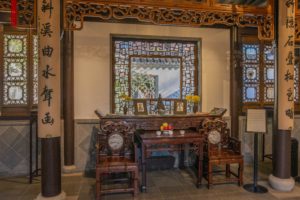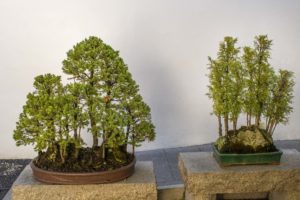Stealing Ideas from a Chinese Garden
Winter is a time for gardeners to rest. No weeding, no mowing, no moving plants from one bed to another. But now is a good time for planning what changes one can make in the garden, come spring and summer. I like to reflect on gardens I have visited, and see what ideas I can steal.
I recently visited the Chinese Garden in Portland, Oregon. At first I looked at the garden and thought to myself, “There really is nothing here that would work in Cornish Flat, NH. Or Providence, or Rutland or Brattleboro – or any of the places my column appears.” But then I realized there were good things to learn from this very formal garden that depends so much on architecture and pools of water.
The Chinese Garden has a formal family shrine in an ornate building with 3 sides and opening to the garden. Inside it has a mahogany sideboard with pictures of ancestors, a bowl of fruit, and tea cups. There were chairs there for family members to repose and think about those who gone on. It’s not the sort of space I could envision for myself – or for most of my readers.
However, the idea of a place in the garden where one can sit and think about loved ones who have passed away is nice. It need not be anything like what I saw in Portland. In fact, I did something back in 2009 after my dear sister, Ruth Anne, passed away. I built a bench using a slab of marble I had bought at a yard sale. I sat the marble on 2 stout cherry logs standing upright. I planted two wild azaleas behind the bench to give the space a sense of enclosure. Then, to one side, I buried some of Ruth Anne’s ashes. Over that spot I planted an umbrella plant (Darmera peltata). I go there and sit on the bench and think of her from time to time, especially when the flowers are blooming in the spring.
The Chinese Garden displays a nice collection of bonsai trees. These are miniatures that are pruned and trained into special forms, and are beautiful – but very labor intensive. To show them off, they are set in place in front of a plain wall so their silhouettes stand out. I have no desire to own a bonsai tree (which may need watering every day, or twice a day in the heat of summer) but I can see using a plain backdrop to show off a potted plant. The house, a stone wall, even a hedge can be brightened up and enhanced with a potted plant.
There was a fragrance garden in the Chinese Garden. Again, I would consider taking this idea and making it my own. Instead of spreading out fragrant plants around my garden as I do now, I could cluster several together and create a place to attract butterflies – and children.
I remember visiting a rose garden in Paris that had a competition each June. One of the categories was “Best Fragrance as Judged by a Child”. I liked that idea, and introduced it as a category in the Cornish, NH annual agricultural fair. You might like to create a fragrance garden this summer in your own garden.
Another feature of the Chinese Garden were spaces enclosed by 3 walls. Although this might have been done for a variety of reasons unknown to me, I saw the spaces as good for delicate plants. Our winter winds are tough on trees and shrubs, particularly those that are marginal in our climatic zone.
If, for example, I wanted to grow a Franklinia tree, I would consider protecting it on 3 sides. Perhaps the house could be one wall, with bamboo fences on the sides. Or perhaps I could enclose it on 3 sides with a living hedge. It is a small tree that is only hardy to Zone 5. It has beautiful bark and white flowers in late summer. This winter I shall ponder where I might put one.
The Chinese Garden used vertical stones as accents. I have been placing vertical stones for decades, though the stones they used were taller and smaller in girth than the ones I use. I like the permanence of stone, and stones show off well in winter against the snow. I plant one third of a stone in the ground for stability, and usually surround the bottom portion with Portland cement – one bag, added dry to the “planting hole”, will harden and serve as an anchor.
Another feature of the Chinese Garden was the use of trees planted and growing at an angle. Most of us are very careful when planting a tree to guarantee that it is vertical – straight up in all directions. But planting a tree at a 45 degree angle can be alluring, too. Both Chinese and Japanese gardens use trees planted on angles. Such a tree does make one stop and look a little longer, just as it would if the leaves were pink or blue, or a color one is not expecting.
The last feature I remarked on at the Chinese Garden were all the pools for fish. Water is very soothing and adds tranquility to a garden. The fish at this garden were koi, a goldfish relative, and quite large. I won’t be adding that feature anywhere in my garden, but I did appreciate them. Perhaps you’ll try one, and invite me to see it.
I’m off soon to see friends in North Carolina and Florida, and hope to see some good gardens. Winter is a good time to get away, and to see new ways to use plants.
Write Henry at PO Box 364, Cornish Flat, NH 03746 or by email at henry.homeyer@comcasst.net Please include a SASE if asking for a response by letter.





